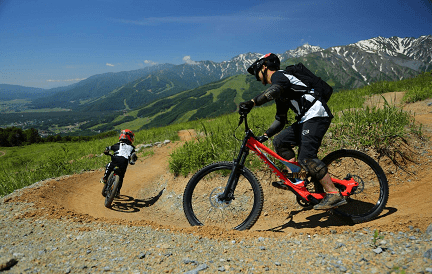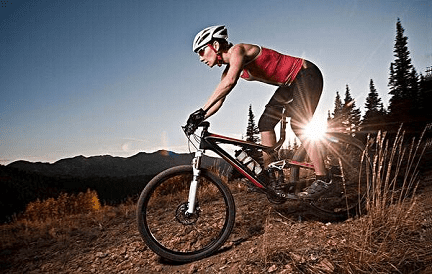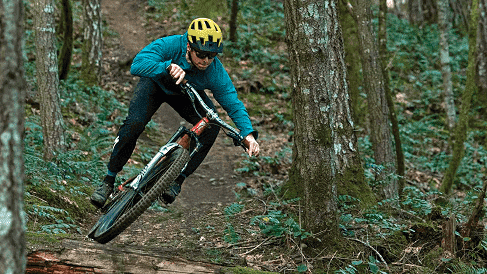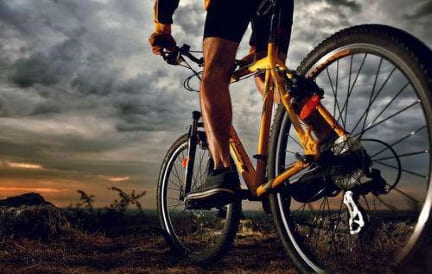Handlebars are one of the essential parts of the mountain bike. It handles the better performance, maneuverability, and comfort of its rider. Carbon MTB bar can help a rider use the full potential of the expensive mountain bike.
An important facet of a mountain bike is that a handlebar is the prior contact point of a rider. If you plan to change or upgrade the handlebars, you would find many varieties available from many brands.
You can’t resist an upgrade since two different handlebars can give much difference to riding your mountain bike on the trail. Hence, you must know to better decide on the best MTB handlebar for your bike.
It is essential to improve the ride quality of your MTB by tweaking its construction even if you are not satisfied with the stock or current setup! At least, carbon fiber MTB bars can help one achieve better control, comfort, and security during a ride!
A right carbon handlebar for your MTB will leave you with lesser pain & aches after your ride. You can better breathe on the climbs and improve the control & cornering on technical terrains with it.
- Part1: Buying Guide
- Part2: Selection Guide
- Part3: How to choose a Mountain Bike Handlebar
- Part4: Frequently Asked Questions
- Part5: Wrapping up
Part1: Buying Guide
While choosing the right product, first you need to have proper knowledge about its specifications. In this manner, you could make a better-informed decision. Let us uncover the main specs of carbon fiber MTB handlebars, including the suggestions for the buyers to choose the best;
Materials & Weight
Generally, Titanium, Alloy, or Carbon are useful to make the handlebars. Among them, Carbon handlebars are more prevalent than others. These are light in weight and consist of flex patterns for more methodically placement of the bars.
Lightweight bikes are considerably better for mountain biking. Thus, you can cut much of its weight by replacing the stock handlebar of MTB with a carbon fiber option.
Rise & Sweep
These factors decide the overall design of the handlebar. Many configurations of different sweep and rise options among handlebars are available in the market. The rise means the vertical rise of the handlebar from its center to the end. It usually varies amid a 40 mm rise but gets even taller to raise the height of the handlebar in a bike.
Sweep is the bend provided in the handlebar and characterize among back sweep and up sweep. You need to look at it from the front, you will find it! Upsweep is the angle amid the parallel imaginary line as per the clamping surface and perpendicular to the handlebar rise. While seeing from the top-down view, the back sweep is the angle between the imaginary lines of the clamping surface to the handlebar.
If you mostly ride in extremely steep terrain, a handlebar with a higher rise might benefit you. A low raise bar can help you keep the weight at the bike front while riding in the steep climbs. A higher rise is vital to put your weight on the back of a bike on steep trails.
Upsweep is a little bit of rising to get the better neutral position of the wrist while riding. A back sweep in the handlebar is also to help in wrist comfort and position during off-roading by angeling the bar ends towards the rider. In comparison to the flatter bar, the more back sweep that a handlebar is having different will be the position of your upper body.
Upgrading to another handlebar with a different back sweep or/and upsweep is convenient. It is good if you have the right idea about the handlebar configurations currently present in your mountain bike. You can go with another configuration that fits well with your use case.
Width
It is for personal preference or to enhance the rider’s comfort as per the local terrain, riding style, and body dimensions. For instance, a taller rider would not like to use the handlebar with a width suitable for not-so-tall riders. A wider handlebar is more stable than a narrower one. However, a narrower bar gives a better sitting position to the biker, so to cover long mile with better endurance.
A less wide handlebar is better for the area having trees and tight trails! In case, you are riding in a dessert, then prefer using a wide handlebar. In this way, the obstacles of taller height would not make any issues. So you do need to consider all such small factors to choose the right width of the handlebar.
If you feel confused about the right width for your purpose, you could prefer to go with the wider one. After all, they consist of designs with cut marks so that if you need, you can cut them down for a few millimeters on each side to narrow it down. The width of a carbon MTB handlebar varies between 750 mm to 800 mm.
The handlebar of the bike is more capable with slacker, and longer geometries. Hence, its handlebar must also be wider for better control and leverage. So, the ridder would be in an ‘attacking’ position. The wider handlebar in the slacker bikes makes them run more stable on the steep bits, jumps, or corners of the trail.
More leverage means a rider can manipulate the front part of the bike. It is possible by lessening the total force required to control the bike while steering, aft & fore, and side to side. A wider handlebar might not be comfortable for all users depending on body size.
Clamp Diameter
Many people have confused among 31.8mm and 35mm options of clamp diameter in the handlebars. The 35 mm clamp diameter stems and handlebars are for a potential increase in durability and stiffness. You can’t only go with more stiffness.
The combo of stem and handlebar is compliant with the trail’s vibration. Both the diameter options can give the same strength. It is a fact that 35 mm diameter handlebars are lighter in weight than the 31.8 mm options. One should have enough flex as per the comfort of the rider.
The bore size or clamp diameter of the handlebar is its width here it matches with the stem. It tapers gradually to the end, where grips are present. The standard clamp diameter found in many handlebars years ago is 31.8mm.
Some DH bikes came with 35 mm clamp diameters. Most of the stem/handlebar interfaces provide more stiffness on the thicker tube circumference. This time, 35 mm handlebar options are lighter than the olden 31.8 mm standard. It is for more variable performance characteristics and durability.
You can find many trail and XC bikes with 31.8mm bikes. The modern endure trail bikes possess 35 mm bars and stems. If comfort and compliance are your preference, you can choose a narrower 31.8 mm bore size. For stiffer and more aggressive rides, you can choose 35 mm. By the way, changing the clamp diameter also demand you to change the stem of compatible size.
Control, Compliance, and Stiffness
Compliance is the material’s elasticity or the possibility of defamation against a force. Stiffness is the ability of a material to resist deformation against force. The handlebars of mountain bikes are tapered intentionally right at the center. It is to make a section on the bar with different compliance characteristics and stiffness.
Such individual separations determine the overall ability of the handlebar. The aim here is to absorb flex, chatter under force at the ends, and be stiff at the center to maintain steering leverage and accuracy. Some riders choose a highly stiff bar to enhance their steering and control input on the bike. The other riders prefer a highly compliant bar that reduces hand fatigue and absorbs trail feedback.

Part2: Selection Guide
Do not blindly go with what your colleague or riding partner prefers to use for the right handlebar for a mountain bike! There are varieties of color and geometry options available with unique technology and features. One can help you improve the overall quality of the product. As per some classifications following are some types of Handlebars suiting to different needs of riders;
Downhill
This kind of mountain bike mostly has the highest rise bars. So for a steep terrain descent, you can manage your weight on the rear wheel.
Enduro/Trail
There are many types of handlebar setups available for these bikes. Carbon MTB bars can handle more vibrations that make your hands feel comfortable in the long or daily run. You can pick one from 10 mm – 35 mm rise to fit with your endurance or trail with ease.
Cross Country
Lower wise handlebars can better fit on these XC bikes. Hence, you can put your body weight on the front wheel helpful for easy technical and steep climbs. A lower rise bar with a long stem can help you apply more power to the bike to deal with the big climbs! It is best to have a lightweight carbon fiber handlebar on the XC bikes.
Overall, a simple upgrade of a handlebar can change the performance and handling of your MTB. Not limited to this, it can also help in saving weight and offer comfort while riding the same on the trail. Again, there are many specifications of carbon MTB bars like varying materials and compliance to consider before you pick one. The list also includes absorbing the vibration, stiffness level, clamp diameter, geometries, and widths.
Part3: How to choose a Mountain Bike Handlebar
You could match any handlebar with any bike. The wide handlebars can give a more aggressive look to the bike. Following are the qualities that you must check in the carbon mountain bike bars before choosing one;
- Better competitive weight
- Durable
- Rich Trail Feedback
- Well, the balance of compliance and stiffness
- Great vibration dampening, could absorb trail chatter
- True tried design
- Better ergonomics for lesser discomfort
- Steering accuracy and leverage cornering
- High-end style and finish
- Adjustable width
- Numbing buzz resistance
- Well thought out, Modern Geometry
- Offer ride with enough balance
- Reduces hand fatigue
Part4: Frequently Asked Questions
After going through the above information, you might have certain doubts. Here are some Q&As, to ease your best carbon fiber MTB bar purchase;
Q1) Is It Worth It to Have Carbon Handlebars
A1) Yes, You might feel carbon fiber handlebars are more expensive than their aluminum counterparts. However, the increased price that you are paying is worth the price. Carbon options offer more stiffness and vibration damping with less weight to handle during a ride. So, riding your bike with small aluminum bars demands more of your arm strength. It is for better grip for better control on the wheels. But, most carbon fiber handlebars are available in different widths hence consuming less of your energy.
Q2) How Much Rise and Sweep in a Bar is Best for Me
A2) 20 mm to 40 mm of high-rise bars are common in DH, endure, and trail bikes. It is to help the rider sit in an upright position while riding the bike with body weight in the center. For better upright body position, you can add rise to the handlebar. Short-rise or flat bars are to get more aggressive and forward body position. The reason is to put more weight on the front part of the bike, like a light trail or XC bike. So you can choose one as per your riding preferences and style. An upsweep of the handlebar for mountain bike is around 5°. The back sweep lies between 7-10 degrees, while 8° is much more common.
Q3) Whether Carbon Handlebars are Durable
A3) The carbon fiber handlebars come with beautiful looks and are lightweight. Yes, they have a good level of shock absorption property and are incredibly stronger. So carbon handlebars are a great replacement for aluminum ones. It is possible by many improvements in material science and manufacturing techniques in the past decade.
Q4) Do Carbon Fiber Handlebars Ensures Safety While Riding
A4) The hands of a rider feel more comfortable on a carbon bar due to the better grip. MTB bars carbon allow the arms and hands to keep energy for the long climb and descent. It is much helpful during cold, rain-soaked, and sketchy descents.
Q5) How to Pick the Right Width for My Handlebar
A5) Usually, the endurance and DH riders can ride with a bar having wideness amid 740-780 mm for women and 780-800 mm for men. The cross-country and trail riders generally use a little narrower bar amid the 740-780 mm range.
If you are confused about the right width, you can stand in front of the flat surface and grab the pair of grips. Naturally, take your hands in front, close your eyes, and imagine that you are riding. It will help you get the correct distance between those grip ends to find the actual bar width you deserve.
You could also find the carbon handlebar of adjustable width having threaded aluminum inserts along both the ends. They can be removed and attached as and when needed without trimming the expensive handlebar. In addition, you can trim down these inserts to get the best width size for your handlebar.
Q6) What is the Cost of Carbon Mountain Bike Bars
A6) You can buy a high-quality carbon fiber handlebar for less than $200, and these are way cheaper than wheels and carbon frames.
Q7) What Width of the Carbon Handlebar From Available Options Fits Best to Me
A7) The length of the carbon fiber MTB handlebars ranges from 750 mm to 1000 mm. You can easily find a handlebar having markings by the manufacturers to cut it to get the perfect width.
Part5: Wrapping up
Carbon fiber bars can give the right balance between resilience, comfort, and stiffness. In addition, you have the choice to use a wide yet light handlebar. A carbon fiber handlebar is a bit higher in price than its aluminum counterpart, but it weighs much lighter. It is comparatively 50-100 grams lesser than the shape and size of the aluminum bars.
Thus, it can help you reduce unnecessary weight from your bike. In addition, MTB bars carbon can also be preferable by experts for better stiffness and lessening the vibration. Besides, the design engineers can also be showing creativity with the layouts and shape of carbon fiber bars. It is to get the performance characteristics as per expectations.
The factors that decide the performance of mountain bikes differ among their users and manufacturers. There is a higher chance that the features and specifications present in your new stock bike are still basic as per your needs. There are chances that you might want an upgrade to achieve more convenience or efficient performance from your bike.
Most of the Original Equipment (OE) belongs to the manufacturer or an affiliate production house. As a rider, you should know how to increase the quality of comfort and ride of an MTB by upgrading the stock handlebar.
For better control and less hand fatigue, you could find MTB bars carbon are of different constructions and materials. The aim is to produce varying levels of compliance, stiffness, and vibration dampening. With proper knowledge, you can customize and personalize the setup of the carbon mountain bike bars. It can help you gain the best performance, comfort, and fit as per your expectations.









